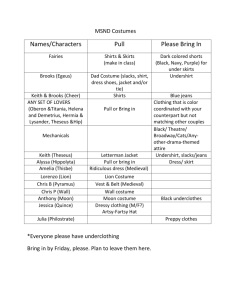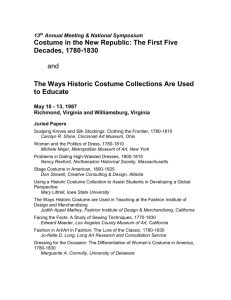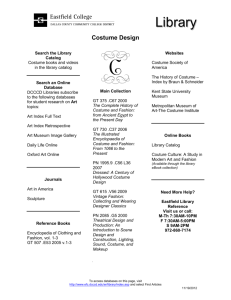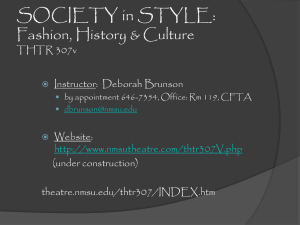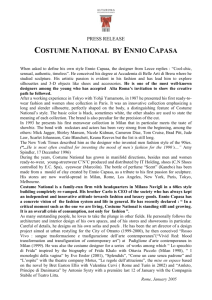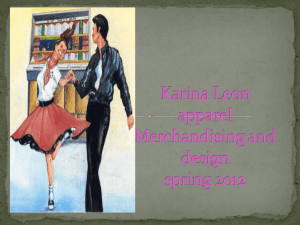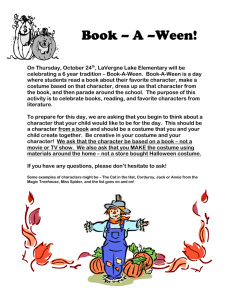History of Fashion - Shakopee Public Schools
advertisement
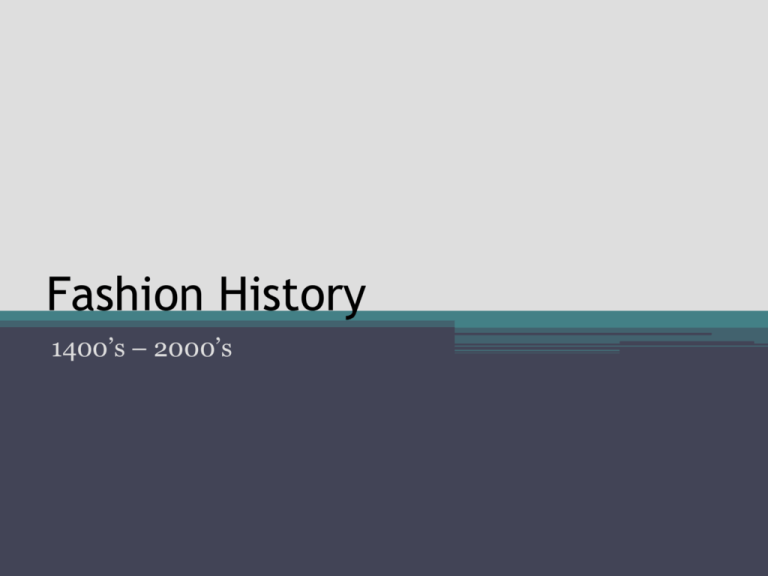
Fashion History 1400’s – 2000’s Guess the fashion era • • • • • • • Clip 1 Clip 2 Clip 3 Clip 4 Clip 5 Clip 6 Clip 7 1. 2. 3. 4. 5. 6. 7. Grapes of Wrath (1930s) Grease (1950s) Pleasantville (1940s) Saturday Night Fever (1970s) Gone with the Wind (1860s) Little Women (1860s) The Great Gatsby (1920s) Time Periods Covered • • • • Northern Renaissance Seventeenth Century Eighteenth Centuiry Directoire and Empire Periods 1790-1820 • Romantic Period 18201850 • Crinoline Period 18501869 • Bustle Period & the Nineties 1870-1900 • Edwardian Period & WWI 1900-1920 • Twenties, Thirties & WWII 1920-1947 • The New Look and beyond 1947-1964 • Sixties & Seventies • Eighties • Nineties Renaissance 1400-1600 • Fashion information was spread by intermarriages of royal families. • Peasants wore clothing for function • Why did royalty care about fashion? • Decorative techniques were applied to outer garments as well as the visible necklines of undergarments. ▫ Embroidery, and lace were popular. • Political alliances were formed, which influenced fashion ▫ Middle East: long robes, gold, velvet turban like hats. Shakespeare in Love Costume for Women Iron Corsets Stomacher Verdugale Bum Roll Wheel Farthingale Petticoat Ruffs Conch Costume for Men Jacket Breeches Truck Hose (padded with bombast) Ruff Peascod Belly Phillip II Henry VIII Edward VI (son of Henry VIII) Seventeenth Century 1600-1700 • Silk was common and popular • Upper class had professional tailors make their clothing. • For the lower class, women of the family did most of the work. Costume for Women • Line of costume grew more soft and square • Low and rounded necklines • Sleeves were multilayered • Ruffs became even larger • Skirt • Gown Costume for Men Shirt Breeches Petticoat breeches Vest Cravat The Eighteenth Century 1700-1790 Reign of King Louis XV, Versailles in France was the center of royal life. His mistress, Madame Pompadour had great influence on fashion. Louis XVI & Marie Antoinette Costume for Women Paniers Hip Pads Costume for Men • Waistcoat • Outercoat • Breeches Directoire & Empire Period • French Revolution • End of King Louis XVI • Beginning of the reign Napoleon • Dress for men was less formal and more egalitarian. • Growth of the textile industry accelerated during the Industrial Revolution 1790-1820 Costume for Women ▫ ▫ ▫ ▫ ▫ Ceased wearing corsets Lightweight Short, set in sleeves Empire waistlines Shawls popular Costume for Men ▫ Waistcoat worn under the coat with breeches or trousers ▫ 3-parts of the suit were rarely the same color ▫ Coats ended at the waistline, curving gradually back into two tails that ended slightly above the knee Romantic Period 1820-1850 • Reaction against the formal classical styles of the 17th and 18th centuries. • Romanticism was a form of rebellion against restrictions on artistic expression. • Preferred other times and places – Middle Ages was a favorite. • Revival of historical dress such as the ruff, ferroniere (chain with a jewel at the center of the forehead), and sleeve styles Costume for Women • Higher class women served as hostesses for their husbands. (Their sleeves were set so low on the shoulder, they were unable to lift their arms). • Working class women had a more practical form, although still followed the same silhouette. • Morning dresses, day dresses, walking dresses, carriage dresses. • Many sleeve styles: marie, demigigot, leg-of-mutton, & imbecile Costume for Men • The most fashionable coats had padding in the shoulder and chest area to emphasize a narrow, sometimes corseted waist. • Waistcoats lengthened and developed a point in front • Lapels narrowed and were less curved • Breeches were limited to sportswear Crinoline Period 1850-1869 • Charles Frederick Worth claims to be the founder of French couture. After his death, his sons expanded the business and formed the Chambre Syndicale de la Couture Parisienne, an organization of couturiers still active today in French couture. • Levi’s jeans came about in 1850. • Invention of the sewing machine. • Isaac Singer developed the most successful machines. Costume for Women • Cage Crinoline. • Dress reform: The Bloomer Costume Costume for Men • Coats did not button shut • Worn open, revealing the waistcoat and trousers • Evening coats were black, some with velvet lapels • Sack jacket (loose with no waistline) Bustle Period & the Nineties 1870-1900 • Skirt fullness shifted toward the back. • Increasing number of women entering the workforce. • Clothing was becoming less cumbersome • Women’s sports became more popular (baseball and basketball). • Department stores first appeared around 1860. ▫ Montgomery Ward, Sears were popular mail-order businesses. • By 1879 men bought most of their clothing in stores Costume for Women • Back fullness was created by a bustle. 3 phases: ▫ 1870-1878: bustle was created by draping the back of the skirt ▫ 1878-1883: Cuirass bodice, fullness dropped below the hips, semicircular frame supported trailing skirts ▫ 1884-1890: large, shelf-like bustles • New corset was developed that ended just below the bust – the brassiere • Leg-of-mutton sleeve popular • Tailor-mades were matching jackets and skirts worn with a blouse. Costume for Men • Lounge coats/Sack coats increased in popularity • Shirts for formal daytime had stiff, starched shirt fronts • Inverness cape 1900’s – S-Curve • The silhouette softened into the S-shaped curve with softer shoulders, less restrictive corsets, and the bustle, never returned. • The three-piece suit for gentlemen was introduced. The suit was relatively non constricting with a sack coat, simple vest, and pleated trousers. • In 1906 the permanent wave was developed. 1900’s 1903 1900’s, Bloomers & Bicycles • Life began to move at a faster pace with many new inventions, such as the telephone, electric light, and the automobile, that gave people more luxury and freedom. The new two-wheeled cycle, was the craze of the country. Amelia Bloomer designed a practical outfit for the avid cyclist consisting of a tunic dress worn over loose trousers gathered at the ankle. Later this was revised into a split skirt with gathers under the knee, called Bloomers. 1896 Bicycle Dress 1900 - The one piece bathing suit was introduced by Annette Kellerman which shocked the world. • 1910 - Men and women wore Dustcoats to protect their clothing when driving or riding in cars. World War I & Fashion • World War I saw fashion come to a standstill with patriotism at an all-time high. • During and at the end of WWI. The barrel silhouette or tonneau look comes in. It is a baggy dress/jacket combination that made women look large and droopy in the chest. Women’s Movement • The women’s movement demanded the right to vote, wear make-up, cut their hair short for the first time in a Bobbed style, and wear skirts above the ankle. 1910’s – The Hobble Skirt • French designer Paul Poiret broke the new rule of freedom by designing the Hobble Skirt. The hemline was so narrow that women could only take very tiny steps. The Pope spoke out in defense of the women, so Poiret split the skirt to the knee, bringing a response of outrage from the public. 1920’s – Tubular • Life began to move ahead and fast. The fashion silhouette at this time was straight up and down or Tubular. • The brassiere was introduced, but it was used to flatten the figure, not uplift or enhance it. • Safe make-up, costume jewelry, and suntans were in great demand. Flapper vs. Thinking Woman • The Flapper wore a headband around her forehead, usually with a feather in front. Her face was powdered, her skirt was the shortest in history, and her knees were rouged. Silk stockings were the rage; they were rolled down just above the knee. The “Thinking Woman” was college educated and considered herself to be the opposite of the flapper. Her dress was emancipated but not extreme. Influence of England • The Prince was the ultimate trend setter of the 1920’s • He often wore Oxford bags, extremely wide trousers, often reaching 25 inches at the knee and cuffed at the bottom. Cardigan sweater, plusfours/oxford bags, argyle socks, wingtip shoes, club stripe tie. Edward 8th Prince of Wales the major social mediator of fashion. Shown here in a suit and overcoat, ascot at the neck. 1920’s - Designers • Paul Poiret vowed, “I will strive for omission, not addition.” This he did with dresses which hung from the shoulders to the wiast, with soft, silky, flowing, sheer fabrics. • Coco Chanel made a hit in fashion using black and navy in simple frill-free designs. She said, “Each frill discarded makes one look younger.” 1930’s – Depression Era • The Depression brought about the classic styles in suits and dresses, clothing that would last a long time and stay in style. The shirtwaist dress was one such classic. • Hand-me-downs became fashionable not only for thrifty families, but for everyone. • Separate skirts and blouses were a highlight, with a white blouse being a must in any wardrobe. • Flap sacks held the powder compact for women’s makeup. • Depression babies had layettes sewn from sugar sacks while school children often wore underwear embellished with the trademarks of Pillsbury flour. combination, were the fashion in millinery wear. 1930’s Hemlines • Hemlines in the 1930’s went down and down again. By the end of the 1930’s fashion seemed to stand still in the shadow of impending war. • Bias cut gowns were popular for evening wear. 1930’s and Movie Stars! • Attention to actresses offstage clothing probably reached its fever pitch with the ensembles created for Gloria Swanson. Ginger Rodgers in a Cowl Neck. Jean Harlow 1930’s Sportswear Pants for women, flared at hem, worn for extreme casual wear only. Also called beach pajamas. 1940’s • World War II (1939-1945) effects fashion directly in this time period. • L85 was a law which restricted the manufacture of clothing. Ruffles were forbidden. Only one pocket per blouse or shirt was allowed. Hems could be no deeper than 2 inches and the widest part of the hem of a dress could not exceed 72 inches. Hemlines rose and leveled off just below the knee. • For men several things were removed: cuffs, vests, 2 pant suits, patch pockets, cloth belts, and pleats. 1940’s • With the fashion industry closed down by the war in Europe, the U.S. was left to its own designers for fashion direction. The designers turned to the military for inspiration. • The Eisenhower jacket made fashion history as it was adopted for civilian use. The shoulders were roomy and cofortable. The “bomber jacket” was based on the Air Corps flying coat made of leather with knit wrist cuffs to keep out the wind. It was usually lined with alpaca fur. The Montgomery beret was the inspiration for hats. Elastic could not be used so a close fitting hat was the sensible choice. This woman was married in a suit quickly for her husband to be shipped out. 40’s Inverted Triangle, broad shoulders & Thin hips • Women began to wear pants as the practical dress for work in industry. It was not too long before pants were popular outside the workplace as a comfortable casual fashion. • The fashion at this time was very manly and the fabric was sensible tweed. The shoulder was square, wide and padded. Suit dresses were very popular and saddle stitching ws a favorite trim. • Men wore colors reflecting the time: khaki and other muted colors. The New Look • Christian Dior • 1947-1954 • Styles of the New Look ▫ ▫ ▫ ▫ ▫ Dropped skirt length Shoulder lines rounded and soft Very full skirts Pencil Slim skirts Small waistline. Rounded curves of the body emphasized. Moments that changed Time: • World War II 1939 - 1945 1950’s Influences on Fashion • Baby Boom • Urban to Suburban • Television Teddy Boy Style • Similar to Zoot Suit ▫ Longer jackets, high turned lapels, narrow trousers The Hippies • Youthful revolt against adult society • Stressed love and freedom • Bottom Up Theory The Feminist Movement • Women began to question traditional values • National Organization for Women (NOW) formed in 1966. ▫ Called for equal rights, equal opportunity, end of sex discrimination. 1960’s 1960’s Style Tribes The Mods and Rockers • Elegance, long hair, granny glasses and Edwardian finery ▫ The Beatles The Hippies • Long hair, beards, headbands, long skirts, gypsy-like costume. 1960’s Space Age Fashion • Precise and unadorned lines • Geometrical shapes • Velcro closures • Plastic jewelry 1970’s Punk Styles • Baggy, messy, ripped clothing • Micro-mini skirts • Safety pins, makeup, colorful hair 1970’s • • • • • • Granny Dress Hip Huggers Hot Pants Poorboy sweaters Wrap Dresses Disco Era 1980’s • • • • Goths Preppies Grunge Hip Hop Culottes Scrunchies Shoes Shorter skirts, lower heeled shoes 1990’s • Grunge (early 90’s) torn jeans, faded denim vests, plain shirts • Hip-hop (late 80’s and after): baggy pants, football or baseball shirts, hats turned backwards. Oversized clothing. • Tweens: MTV, loyalty to brands, influence of music and pop stars • The Matrix, Spice Girls & Britney Spears

